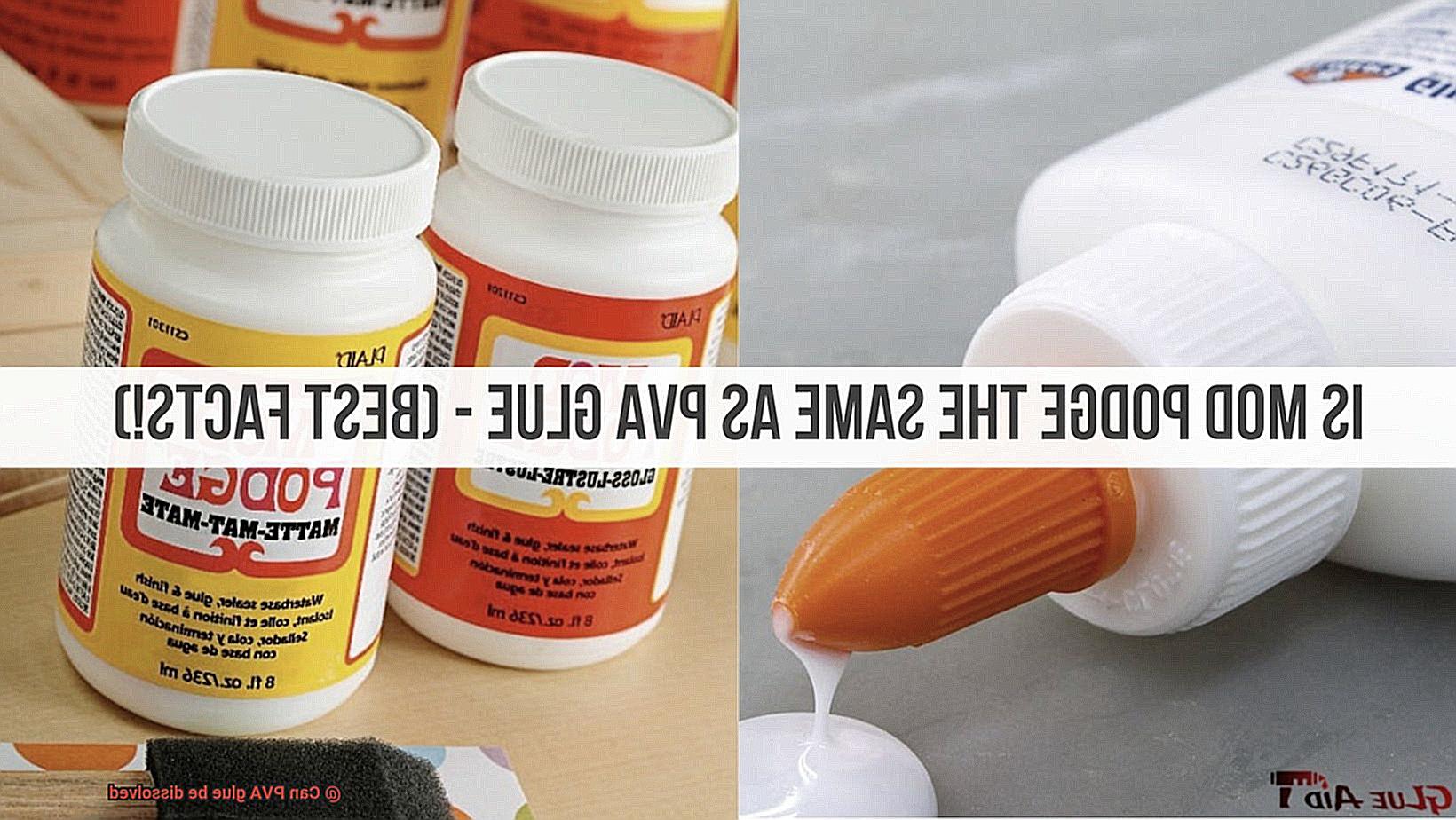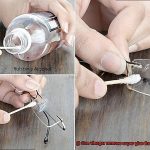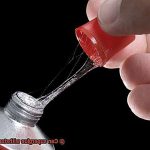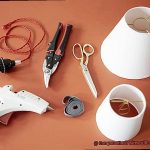Are you in a sticky situation where PVA glue is causing havoc on your surfaces? Perhaps you’ve spilled it on your clothes or carpet, and now you’re struggling to find a way to remove it. Fear not, because PVA glue can be dissolved. This popular adhesive is used in various industries such as crafting, woodworking, and construction. The question remains – how do you dissolve PVA glue?
The answer is simple – there are several methods to dissolve PVA glue depending on the type of surface and glue you’re dealing with. Whether it’s wood, fabric, or plastic that’s affected, there’s always a solution.
This blog post will explore different ways to dissolve PVA glue effectively. From using warm water and soap to acetone and alcohol, we’ll cover everything you need to know to remove PVA glue like a pro.
So buckle up and get ready for some valuable tips and tricks for removing PVA glue from any surface. Your crafting projects, DIYs, and woodworking will thank you for this knowledge.
Advantages of Using PVA Glue
Contents
Its numerous advantages make it a top choice for a variety of applications.
Versatility is one of the main advantages of PVA glue. Its ability to bond to a wide range of surfaces, including wood, paper, and fabric, makes it an ideal choice for different projects. From woodworking to crafting, PVA glue has got you covered.
Ease of use is another great advantage of PVA glue. Unlike some other types of adhesives, PVA glue can be easily applied with a brush or roller. It dries clear, making it perfect for projects where appearance is important. No more worrying about unsightly glue marks.
Furthermore, PVA glue is water-soluble. This means that any excess glue can be easily cleaned up with water. This feature comes in handy when you need to remove excess glue or if the glue spills onto clothing or other surfaces.
In addition to its ease of use and versatility, PVA glue is also non-toxic and safe for use around children and pets. It’s a popular choice for school projects and other activities involving children. No need to worry about harmful chemicals.
When Do You Need to Dissolve PVA Glue?
As a crafter, you know the importance of having a reliable adhesive at hand. PVA glue is a popular choice due to its versatility and ease of use. But what do you do when you need to adjust or clean up excess glue? That’s when knowing how to dissolve PVA glue becomes essential.
First and foremost, you must check the label on your glue bottle. Not all PVA glues can be dissolved, so make sure you’re not attempting the impossible. If your glue is water-soluble, soaking the item in warm water should do the trick. For permanent glue, you may need to use solvents like acetone or rubbing alcohol, but be cautious as they can damage certain surfaces and should only be used in well-ventilated areas.
Here are a few scenarios where you might need to dissolve PVA glue:
Accidentally glued two pieces of paper together? Dissolving the glue will allow you to separate them without damage.
Your crafting session went awry, leaving excess glue on your project? Dissolving it will give a cleaner finish.
Need to make adjustments to your project? Dissolving the glue allows for easier repositioning.
Remember, however, that dissolving PVA glue may not always be necessary or the best option. In some cases, it may be better to cut or scrape away excess glue instead of risking damage to your project by dissolving it. And if you’re working with delicate or valuable items, it’s always best to consult a professional before attempting any kind of glue removal.
How to Dissolve PVA Glue with Water
PVA glue, also known as white glue or school glue, is a versatile adhesive that is frequently used in a wide range of projects. However, it can be frustrating when it gets stuck to surfaces or objects where it shouldn’t. Thankfully, dissolving PVA glue with water is a straightforward process that requires only a few simple steps.
Step 1: Prepare a bowl of warm water.
To dissolve PVA glue with water, begin by preparing a bowl of warm water. The temperature of the water should be between 50-60°C (122-140°F). Warm water is effective in breaking down the bonds in PVA glue.
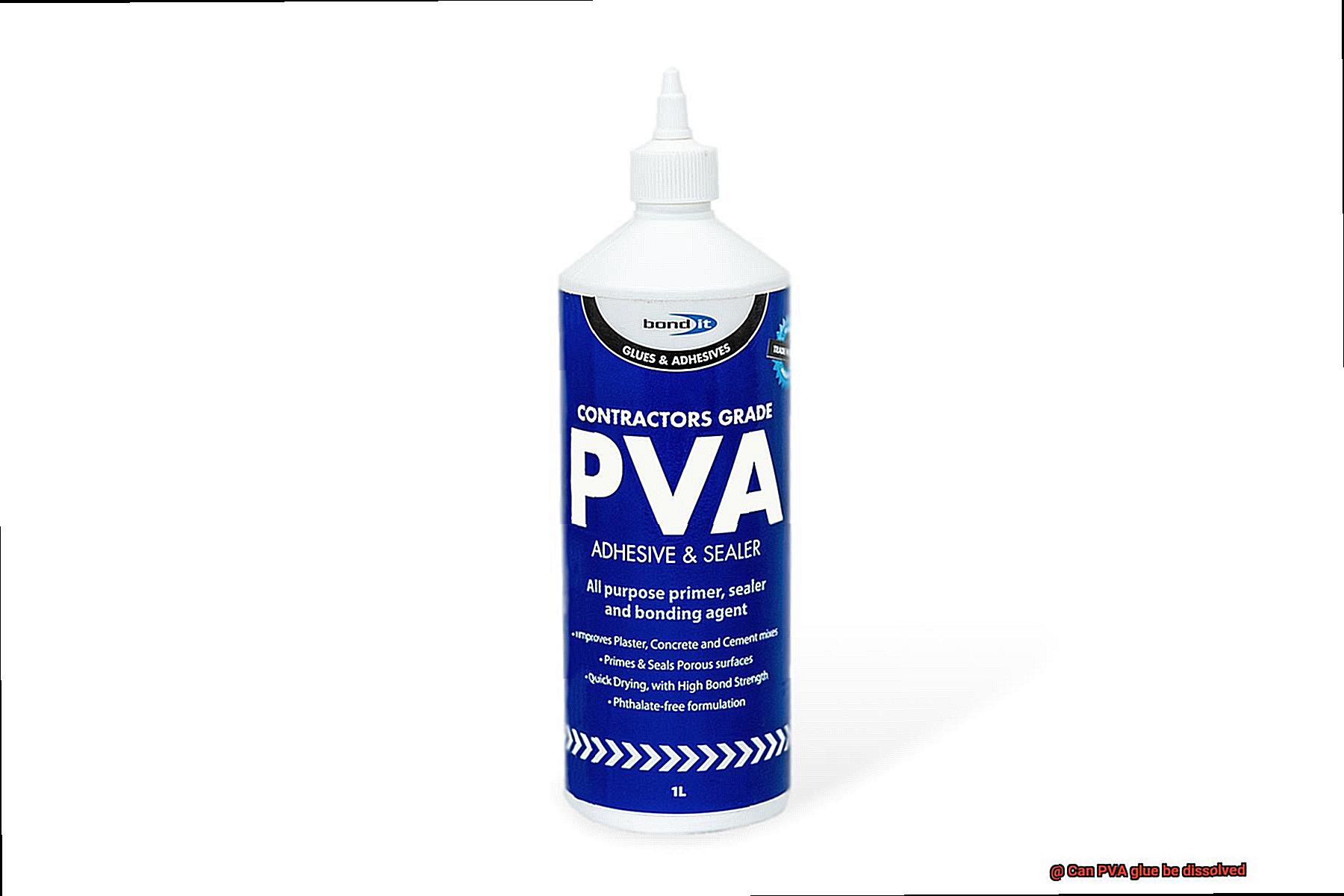
Step 2: Soak the affected area in warm water.
If you are trying to dissolve PVA glue from a surface, use a cloth or sponge to soak up the warm water and apply it to the affected area. If you have an object with PVA glue on it, immerse it entirely in the bowl of warm water.
Step 3: Allow time for the PVA glue to soften.
Once the area or object is immersed in the warm water, leave it there for at least 30 minutes. This gives enough time for the water to penetrate and soften the PVA glue.
Step 4: Gently scrub the surface or object.
After soaking for at least 30 minutes, take a soft-bristled brush or toothbrush and gently scrub the area or object. This helps to loosen up the PVA glue from the surface and accelerates the dissolving process.
Step 5: Rinse off any remaining PVA glue and dry off with a towel.
Once you have scrubbed away as much of the PVA glue as possible, rinse off any remaining residue with clean water. Dry off with a towel.
It’s worth noting that this method may not work on all types of surfaces or PVA glues. Additionally, some PVA glues may require additional solvents or methods for complete removal.
How to Dissolve Dried and Hardened PVA Glue
There are various methods available that can help dissolve the glue and make it easier to remove. Let’s explore some effective ways to dissolve dried and hardened PVA glue:
Warm Water and Soap
Soaking the affected area in warm soapy water for several hours is a simple yet effective method to dissolve PVA glue. The warm water helps soften the glue, making it easier to remove. This method is ideal for removing glue from non-delicate surfaces.
Vinegar or Alcohol
Vinegar or acetic acid can break down the bond between the glue and the surface it’s stuck to, making it easier to remove. Simply soak a cloth or sponge in vinegar or alcohol and apply it directly to the glue. Allow it to sit for several minutes before wiping away the softened glue with a scraper or toothbrush.
Commercial Adhesive Remover
For tougher jobs, such as removing PVA glue from clothing or upholstery, a commercial adhesive remover may be necessary. These products are specifically designed to dissolve all types of adhesives, including PVA glue, without damaging the underlying surface.
However, always follow the manufacturer’s instructions carefully and test the product on a small, inconspicuous area before using it on a larger scale.
Sanding or Scraping
If the above methods do not work, sanding or scraping may be necessary. However, it’s crucial to use these methods with caution as they can damage delicate surfaces or create dust that may be harmful if inhaled. Always wear protective gear such as gloves and a mask when using these methods.
Residue Removal
It’s important to note that PVA glue may not dissolve completely with these methods and may leave behind some residue. In this case, sanding or scraping may be necessary to fully remove the dried glue. Additionally, always test these methods on a small, inconspicuous area before using them on a larger surface to ensure they do not damage or discolor the material.
Potential Risks of Dissolving PVA Glue
PVA glue is a versatile and commonly used adhesive in numerous projects, from arts and crafts to woodworking and industrial applications. However, there are instances where dissolving PVA glue is necessary, whether it’s for cleaning up mistakes or removing excess glue. Nevertheless, dissolving PVA glue is not without risk, and it’s important to be aware of the potential hazards involved.
One of the primary risks of dissolving PVA glue is the emission of toxic fumes. Vinyl acetate, a component of PVA glue, can emit harmful fumes when exposed to heat or specific chemicals. These fumes may irritate the eyes, nose, and throat, and if inhaled for an extended period, can cause respiratory problems. Therefore, wearing appropriate protective gear such as gloves and respiratory masks is essential when handling chemicals or solvents required to dissolve PVA glue.
Another risk to consider is the possible damage that dissolving PVA glue can cause to surfaces. While PVA glue is water-soluble, using certain chemicals or solvents can harm surfaces such as wood, plastic, or fabric. It’s crucial to test a small area first before dissolving PVA glue on a larger scale to avoid unwanted damage.
Moreover, dissolving PVA glue can also weaken its adhesive strength. Although PVA glue is renowned for its robust bonding properties, dissolving and reapplying it may not achieve the same level of strength as before. This can be a safety concern in industrial or construction environments where strong bonds are crucial.
Considerations Before Attempting to Dissolve PVA Glue
Whether you’re fixing a mistake or removing a project, it’s crucial to take some vital considerations into account before you start.
Firstly, it’s essential to identify the type of surface the glue has been applied to. Some surfaces may not react well to the solvents used to dissolve the glue. Therefore, it’s best to test a small area first or seek professional advice.
Secondly, consider the age and condition of the glue. If it’s old and hardened, it may require a different approach than fresh or still-wet glue. Don’t waste time and effort using an ineffective method; instead, choose a solvent that is appropriate for your specific situation.
When choosing a solvent, there are many options available, but safety should be your top priority. Some solvents can be hazardous or flammable, so make sure to read labels carefully and take proper safety precautions. Wear gloves and protective eyewear, ensure proper ventilation in your work area, and keep any solvents away from open flames or other sources of ignition.
It’s also essential to consider the potential effects of dissolving PVA glue on surrounding materials or surfaces. Depending on the solvent used, it may be necessary to protect adjacent surfaces or materials from damage or discoloration.
Alternatives to Dissolving PVA Glue
Sometimes, things don’t go as planned, and you’re left with unwanted glue residue on your project. Fear not, as there are alternative methods to dissolve PVA glue that can be just as effective.
Firstly, if you’re working with hard surfaces like wood, metal, or plastic, a scraper or spatula is the simplest tool to remove dried glue. Gently scrape off the glue from the surface, being careful not to apply too much pressure as it can damage the surface. This method is particularly useful when removing large chunks of glue.
If scraping isn’t an option, try using heat to soften the glue. A heat gun or hair dryer can do the trick. Gently apply heat to the glue until it softens and then use a scraper or spatula to remove it. But remember, excessive heat can damage the surface, so use caution.
For those who prefer natural solutions, vinegar is an excellent option. Apply vinegar to the affected area and let it sit for a few minutes before wiping it off with a damp cloth. This method is safe for most surfaces and leaves behind a pleasant scent.
Lastly, rubbing alcohol can also be used to remove PVA glue effectively. Apply it directly to the glue and let it sit for a few minutes before wiping it away. But be cautious when using rubbing alcohol as it can damage some surfaces. Test on a small inconspicuous area first before applying it on a larger scale.
Also Read: Will Elmer’s glue dissolve in water?
Conclusion
In summary, dissolving PVA glue is not only possible but also necessary in many cases. Whether you’re a professional craftsman or a DIY enthusiast, knowing how to remove excess or dried glue can save time and prevent headaches. PVA glue is a versatile adhesive that’s widely used in various industries due to its water-solubility and ease of use. However, removing it requires caution and consideration of potential hazards.
Fortunately, there are several effective methods for dissolving PVA glue depending on the surface and type of glue you’re dealing with. Warm water and soap, vinegar or alcohol, commercial adhesive remover, sanding or scraping are all viable options. However, before using any of these methods on a larger surface, it’s crucial to test them on a small inconspicuous area first to avoid unwanted damage.
Additionally, alternative methods like using a scraper or spatula for hard surfaces or applying heat to soften the glue can also be effective. With these tips and tricks at hand, you can confidently remove unwanted PVA glue from any surface like a pro.

